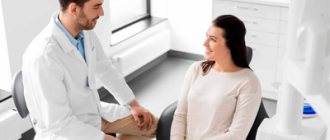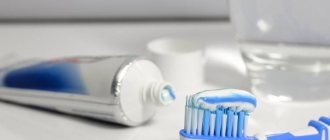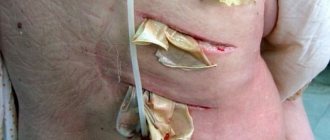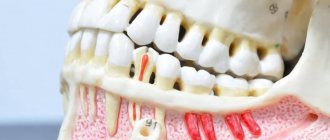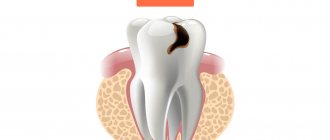Reasons for the development of pathology
The formation of an acute purulent process in the subcutaneous fat layer near the lymph nodes can be triggered by a significant decrease in immunity. If there is inflammation of the lymph node itself, then a delay in lymph outflow and increased vascular permeability are observed.
Adenophlegmons develop due to ongoing inflammatory processes of any localization. Often this pathology is diagnosed against the background of malignant tumors, some types of dermatitis, chronic dental pathologies, and inflammation of the tonsils.
Diagnostics is aimed not only at identifying adenophlegmon, but also at establishing the cause of its occurrence - medical tactics for this pathology depend on this.
Causes of adenophlegmon
Purulent inflammation of the subcutaneous fat, like any other purulent inflammation, has a clear cause. This is an external or internal infection, most often with coccal flora. As a result of a decrease in the body’s defenses of an exogenous-endogenous nature (focal and perifocal infection, especially in the area of the tonsils, oral cavity, kidneys, previous illness, skin trauma, more often post-injection, pyococcal damage to the dermis), the anti-infective barrier of the lymph nodes decreases.
Typically, lymph nodes and lymphatic vessels, together with the venous system, ensure the natural outflow of fluid from tissues and organs. During inflammation, this plays a decisive role, since in the early stages of development of the process, lymph flow slows down, vascular permeability increases, conditions are created for the accumulation of microbes in the lymph nodes, where pathogenic flora is absorbed by the cells of the reticuloendothelial system, the remnants of microorganisms are broken down, and released into the circulatory system, where they die under the influence of antibacterial therapy. If inflammation increases, the lymphatic vessels thrombose, blocking the outflow, blocking the spread of the inflammatory process. Against this background, microbes from the lymph nodes leak into nearby tissues, causing inflammation in them and forming adenophlegmon.
Classification of adenophlegmon
Adenophlegmons are usually distinguished by the localization of the inflammatory process. The most significant in terms of severity and possible consequences:
- adenophlegmon of the lower jaw and chin is the most common option;
- adenophlegmon of the neck - a consequence of violations of personal hygiene of the oral cavity, auricle, and scalp;
- adenophlegmon of the groin area - the result of hypothermia;
- adenophlegmon of the axillary region - a consequence of infection of skin microtraumas;
- adenophlegmon of the parotid region is a septic complication.
Symptoms of adenophlegmon of different types
Symptoms depend on where adenophlegmon developed:
- With submandibular adenophlegmon, body temperature rises, swallowing may be difficult, problems with speech arise, swelling forms in the affected area, redness of the skin and pain when palpated are observed.
- With adenophlegmon of the neck, symptoms appear only when there is a critical accumulation of coccal microflora in the tissues of the anterior or lateral part of the neck. There is an increase in body temperature, pain when feeling the neck, redness of the skin, but swelling may be absent.
- With inguinal adenophlegmon, the clinic develops against the background of an inflammatory process in the genitourinary system. This type of adenophlegmon is characterized by rapid progression, while the patient experiences severe pain, due to which he cannot move freely. There are also signs of general intoxication of the body.
- With adenophlegmon of the axillary region, symptoms more often occur with open wounds of the upper extremities. Signs are pronounced: enlargement of regional lymph nodes, deterioration of general condition (including increased body temperature).
The symptoms for different types of pathology in question are similar, the differences lie only in the location of the lesion. If adenophlegmon occurs in children, then loss of appetite, increased drowsiness, lethargy, and lack of interest in games and others will be noted.
Therapy and surgery of the inflammatory process
Since the inflammatory process is characterized by a severe course, the patient is hospitalized immediately after phlegmon is detected. Treatment is carried out in a surgical hospital.
At the initial stage, before the accumulation of infiltrate, the patient is prescribed local therapy - warming compresses, Sollux, UHF procedures, and yellow mercury ointment is also applied to the affected area.
In the presence of suppuration, surgical opening of the inflammatory focus and removal of purulent contents is performed, followed by drainage of the cavity. Thanks to the removal of pus, tissue tension is relieved and conditions are created for the unhindered separation of exudate and cleaning of the purulent focus. Surgical treatment of phlegmon is performed under general anesthesia.
To further heal, apply antibiotic ointment to the wound and cover it with a bandage. The drug is selected in accordance with the identified causative agent of infectious inflammation after checking its resistance to the drug. If necessary, painkillers are used for intramuscular injection.
In the anaerobic form of inflammation, the patient is injected with anti-gangrenous serum to increase the body's resistance to infection.
During the recovery period, the patient is prescribed bed rest and conservative restorative therapy. The administration of antibiotics continues until the end of the acute phase of inflammation. At the same time, the patient can be prescribed immunomodulators, vitamins, calcium chloride, and glucose solution.
If you consult a doctor in a timely manner, the prognosis is usually favorable. In the case of a large-scale inflammatory process, noticeable scars or other defects may form, as well as a decrease in the function of the affected tissues. To prevent phlegmon, foci of infection should be promptly eliminated: treat carious teeth, pyoderma, boils, etc., treat wounds and abrasions with an antiseptic until complete healing.
Treatment of anderophlegmon
The solution to the problem is to carry out complex treatment:
- The purulent focus is opened under local anesthesia or general anesthesia;
- it is being sanitized;
- install drainage without suturing the wound;
- apply a sterile bandage with a mandatory change once a day.
When treating adenophlegmon, antibiotics are used - not only in the form of tablets or injections, but also topically, to wash the abscess cavity. If you seek qualified medical help in a timely manner, the prognosis is favorable. But we must not forget that there is a high risk of developing sepsis.
Information about in what cases adenophlegmon of the floor of the mouth develops and what features of treatment of the disease you need to know is contained on our website https://www.dobrobut.com/.
Cellulitis of the neck
Effective treatment of a patient is possible only if he or she seeks specialized medical care in a timely manner. The purulent-inflammatory process rapidly progresses, which every hour worsens the prognosis, increases the likelihood of complications and the risk of death. Medical tactics for phlegmon involve emergency surgery, the prescription of antibacterial and anti-inflammatory drugs, and detoxification therapy.
Conservative treatment
Conservative therapy is carried out mainly in the postoperative period with the aim of accelerating the cleansing and healing of wounds, preventing disorders of the cardiovascular system and internal organs. Prescribing infusion therapy, enteral and parenteral use of drugs is advisable in the following cases:
- Correction of hypovolemic disorders.
The patient's serious condition and low blood pressure require infusions at the stage of preparation for opening the phlegmon to reduce the risk of intra- and postoperative complications. The introduction of saline solutions, glucose solution in combination with diuretics additionally helps to reduce the level of intoxication. - Postoperative drug therapy.
In the hospital, broad-spectrum antibiotics are prescribed; after receiving the results of bacteriological examination, drugs with maximum sensitivity of the isolated flora are introduced into the treatment regimen. Anti-inflammatory, painkillers and other medications are used according to indications.
Surgery
The only way to stop the spread of infection in tissues is to create optimal conditions for the outflow of pus by widely opening the phegmon. The scope of surgical intervention is determined by the degree of spread of the purulent-inflammatory process, the involvement of the mediastinum and includes the following mandatory steps:
- Opening the affected area
. The surgeon makes a significant incision in the projection of the lesion, widely opening the fascial space of the neck. If possible, mediastinal tissue involvement is determined through an incision in the neck. If this is not enough, an additional incision is made in one of the intercostal spaces to inspect the mediastinal tissue. With odontogenic phlegmon, the area of the retromandibular fossa, the floor of the mouth, is opened. - Cleansing the wound
. The pus is evacuated. The wound is washed abundantly with antiseptic solutions during the operation, and then repeatedly during dressings until it is completely cleansed. The wound is not sutured to facilitate drainage and the possibility of subsequent staged necrectomy. The average duration of wound surface cleansing is 18-22 days. - Drainage
. Drains are installed in incisions in the neck, and if there are signs of mediastinitis, in the mediastinum area. The locations of the drainage tubes are determined by the areas of the chest affected by the inflammatory process. The drainage tubes are connected to containers into which exudate is collected. The intensity of the pathological process in the tissues is judged by the amount of exudate.
Experimental treatment
The patient's condition during the formation of neck phlegmon is largely determined by the high concentration of decay products of necrotic tissues and the vital activity of bacteria. Toxins are eliminated through the blood and lymph; the ratio of the contribution of both detoxification pathways is 1:6. In this regard, methods for correcting the functions of the lymphatic system through indirect endolymphatic infusion of drugs are being developed and applied. The method is used as an auxiliary method in relation to surgical treatment.
Diagnosis and treatment of adenophlegmon
The clinical picture and anamnesis of the disease are typical. Additionally, ultrasound of soft tissues and x-ray diagnostics are used to exclude osteomyelitis, tumors, and cysts. OBC, OAM, blood biochemistry, blood test for sterility are required. To prescribe etiopathogenetic therapy, culture of punctate purulent lesions on nutrient media is used, followed by determination of sensitivity to the antibiotic. Purulent inflammation is differentiated from phlegmon (choice of surgical intervention), tuberculosis, actinomycosis, osteomyelitis, periadenitis, inflammatory infiltrate, osteophlegmon. Purulent surgeons treat pathology.
Treatment of the disease is complex. The severity of the process dictates the need for urgent surgical intervention in a hospital setting. The phlegmon is opened and drained. The wound is treated in an open manner with washing, administration of antibiotics and enzymes, and dressings. Postoperative antibacterial, anti-inflammatory, and detoxification therapy is mandatory. They include means for general strengthening of the body (vitamin therapy) and increasing immunity (immunostimulants, immunomodulators). It is necessary to sanitize all foci of chronic infection. Prevention consists of timely diagnosis and treatment of chronic infections and strengthening the immune system. The prognosis with timely diagnosis and treatment is favorable.
Diagnosis of Adenophlegmon:
Differential diagnosis is carried out with phlegmon in osteomyelitis (osteophlegmon), periadenitis, inflammatory infiltrate. The difficulty in making a diagnosis arises in the early stages of the process, when one nosological form (for example, periadenitis) in its dynamic development, in the absence of treatment, passes into another. The main thing in this case is to correctly determine the nature of the inflammation - purulent or non-purulent. Differential diagnosis with osteophlegmon is also extremely important, since the methods of surgical care for these types of phlegmon are different.
User Questions (6)
- Evgeny 2018-03-01 21:49:07
When I fell on the glass, I cut my jaw. At the hospital the cut was stitched up. But after 2 days it became bad, they sent me to surgery, they opened the wound, and it was discovered that the salivary gland was affected. They diagnosed phlegmon. U... read the answer >> - Olga 2018-02-03 13:54:20
Hello! After the removal of the lower wisdom tooth, facial phlegmon formed, I was operated on. The incision healed normally, but a month later a small rash appeared in the place where the phlegmon was, in some places... read the answer >> - Irina 2017-02-17 17:40:18
Hello, after the removal of the seventh tooth on the lower right, a phlegmon formed, I spent a week in surgery, today I was discharged home, but there was a lump under my chin, they didn’t open it, they dropped methadone... read the answer >> - Alexey 2016-11-20 11:32:14
Hello. There was phlegmon of the lower jaw under the lingual. They had an operation. As of today, the stitches have been removed, a week has already passed. But in one place it does not linger and the Treasure stands out abundantly. Which... read the answer >> - Tatyana 2016-05-20 17:08:16
We had an autopsy of the phlegmon, but the tumor remained - the wound had not yet completely healed. tell me whether the ointment will draw out the liquid or be sure to consult a doctor (the person cannot walk, but they take him to the hospital... read the answer >> - Tamara 2015-12-03 02:16:33
Hello! I constantly have a clicking sound in my ear and it hurts to chew. They prescribed painkillers, UHF, etc., nothing helps, there is no dislocation on the X-ray, the dentist suspects “Arthrosis”... read the answer >>
Medical institutions you can contact:
Dental Office, network of dental clinics all addresses Orto Plus, dental office DiaGroup, medical center all addresses Biomed, dentistry Aristocrat, dental clinic SENDO, medical center Apollonia, dental office Zubok, dental clinic Doctor Gis, dental clinic Nor-Stom, dental office Dentline, dental clinic all addresses Delta, dentistry Denta-Lux, dental clinic DOCTOR, medical center Generation, medical center all addresses Diamant, dental clinic Favorite dentist, dental center Nika Spring, network of medical centers all addresses Dentist and I, dental office (Yunist ) SMILE, dental center
Treatment of phlegmon
Treatment of phlegmon is surgical - opening the abscess, excision of necrotic tissue (see photo below).
In the photo, the phlegmon is opened, the Achilles tendon is visible at the bottom of the wound.
After opening the abscess, the wound is cleaned, inflammation subsides, and wound healing processes begin.
In the photo, the wound has cleared and is beginning to heal.
In the complex treatment of phlegmon, antibiotics, immunocorrectors, physiotherapy, etc. are also used.
The photo below shows phlegmon of the left forearm, which developed from a boil.
In the photo below, the same phlegmon is opened, the wound is cleaned.
The photo below shows the same wound, almost healed.
The wound has healed.
The photo below shows advanced phlegmon of the thigh. The duration of the disease is 2 weeks.
The patient refused hospitalization, so treatment of phlegmon had to be carried out in a clinic. In the photo below - the same phlegmon 7 days after the operation - the wound has cleared and is granulating.
After cleaning the wound, secondary sutures were applied (photo below).
Pathogenesis of Adenophlegmon:
The occurrence of adenophlegmon is a manifestation of the failure of the barrier-fixing function of the lymph node, in which filtration of lymph occurs, retention of microorganisms by reticuloendothelial cells and their phagocytosis with the transfer of information about their antigenic structure to the immunocompetent organs. When the outflow pathways from an inflamed lymph node are blocked, microorganisms and their metabolic products of an antigenic nature can penetrate through the lining of the lymph node into the surrounding tissue, causing inflammation in it. Clinical picture. From the anamnesis it is often possible to find out that the onset of the disease was preceded by trauma, inflammatory processes of the scalp, mucous membrane of the oral cavity, nose, and tonsils. Then, in the suprahyoid region, in the neck area, a moving, painful “ball” with clear contours appeared. As the “ball” grew larger, it lost its clear contours, and signs of the body’s general reaction such as headache, general malaise, and increased body temperature became more pronounced. Complaints and objective examination data, reflecting the local picture of the inflammatory process, depend on the localization of adenophlegmon. With a similar localization and prevalence of the infectious-inflammatory process, the disturbance of the general condition and the severity of the general reactions of the body in patients with adenophlegmon are usually less than in patients with phlegmon. The possible complications are the same as in patients with phlegmon: progressive spread of the infectious-inflammatory process to adjacent anatomical areas, spaces and vital organs (brain, its membranes, mediastinum), generalization of infection - development of sepsis, increasing cardiopulmonary, renal , liver failure as a result of infectious-toxic damage to these vital organs and systems.
